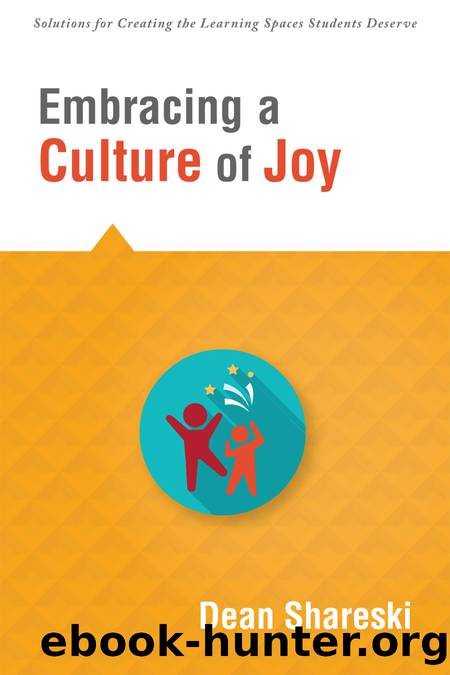Embracing a Culture of Joy by Shareski Dean;

Author:Shareski, Dean;
Language: eng
Format: epub
Publisher: Solution Tree
Published: 2017-08-15T00:00:00+00:00
â¢What do you wonder about? Have you shared this with your students?
â¢How can you be more intentional about your personal and professional curiosity?
Chapter 5
Play as Research
The highest form of research is essentially play.
âN. V. Scarfe
In Doug Thomas and John Brownâs (2011) A New Culture of Learning, the authors make it clear that play is essential in making sense of a world full of new opportunities: âIn a world of near-constant flux, play becomes a strategy for embracing change, rather than a way for growing out of itâ (p. 48). Play is no longer something only children should experience. Stuart Brown, president of the National Institute for Play, describes play as âanything that spontaneously is done for its own sakeâ (as cited in Tippett, 2014).
Research suggests that play should remain an integral part of learning, not just in the early years but for life (Caine, 2013; Conklin, 2014). Again, looking to Finland, schools find great success in their early-years programs not by eliminating play but by embracing it. In fact, the article âThe Joyful, Illiterate Kindergartners of Finlandâ examines the playful nature of schools in structured and thoughtful ways designed to expose students to natural, joyful learning opportunities (Walker, 2015). Now when it comes to learning, technology affords us endless opportunities for play. Apps and devices alone give us a chance to try new ideas with low risk. Clay Shirky (2008) notes, âCheap failure, valuable as it is on its own, is also a key part of a more complex advantage: the exploration of multiple possibilitiesâ (as cited in Sivers, n.d.).
As someone who began teaching in the late 1980s, trying new things in the classroom was complicated. Using new resources or pedagogies required time and expertise that I lacked as a young teacher. I had limited access to materials and new ideas. As I continued my career, emphasis on using research-based ideas and best practices added further caution about venturing into unknown territories.
The advent of the Internet and digital technologies offered a resurgence in my enthusiasm and provided new possibilities for play that I never had previously. Access to ideas and people meant that I was exposed to a plethora of ways to engage my students. Using digital media meant I could supplement my teaching with visuals that took my students to places not possible before. Sites like Discovery Education, YouTube, and Skype added even more means to teach differently. Watching my role shift from instructor to guide and designer was both effective and challenging. When I shared something new with colleagues, I was often met with uncertainty around its value, how difficult it might be to implement, and how it fit with the research. The problem was that for many of the things I was trying, like Skyping in experts or creating videos, there was no research. The best I could do was read what others around the world were doing via personal blogs.
Download
This site does not store any files on its server. We only index and link to content provided by other sites. Please contact the content providers to delete copyright contents if any and email us, we'll remove relevant links or contents immediately.
Macmillan Primary Grammar 2 Pupil's Book by Unknown(379)
Figuring Out Fluency in Mathematics Teaching and Learning, Grades K-8 by Jennifer M. Bay-Williams & John J. SanGiovanni(343)
The Principal's Guide to Curriculum Leadership by Sorenson Richard D.;Goldsmith Lloyd M.;Mendez Zulma Y.;Maxwell Karen T.;(266)
English Grammar Practice--The Noun by Roxana Nastase(228)
Learning from Accidents 3rd ed by Trevor Kletz (2001)(226)
Harnessing Technology for Deeper Learning by Scott McLeod(215)
Text-Dependent Questions, Grades K-5 by Douglas Fisher & Nancy Frey & Heather Anderson & Marisol Thayre(211)
A Guide to Curriculum Mapping by Hale Janet A.;(202)
English Language Program Administration by Unknown(199)
Deep Change Leadership by Reeves Douglas;(190)
How to Do Everything with Google Tools by Unknown(188)
The Grammar Teacher's Activity-a-Day by Jack Umstatter(178)
The Power of SMART Goals by Conzemius Anne;O'Neill Jan; & Anne Conzemius(177)
Beyond the RTI Pyramid by Bender William N.;(158)
Aligning and Balancing the Standards-Based Curriculum by Squires David A.;(156)
Using Data to Close the Achievement Gap by Johnson Ruth S.;(156)
Using Equity Audits to Create Equitable and Excellent Schools by Skrla Linda E.;McKenzie Kathryn B.;Scheurich James Joseph;(151)
Differentiated Instructional Strategies for the Block Schedule by Gregory Gayle H.;Herndon Lynne E.; & Lynne E. Herndon(145)
You've Got to Reach Them to Teach Them by Schreck Mary Kim; & Schreck(140)
